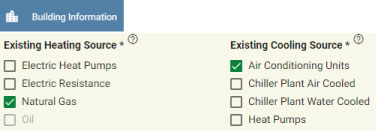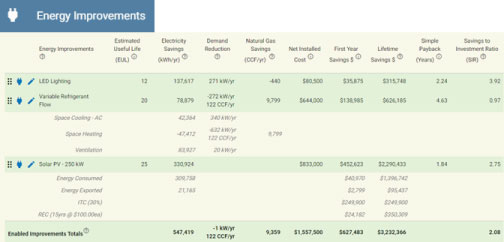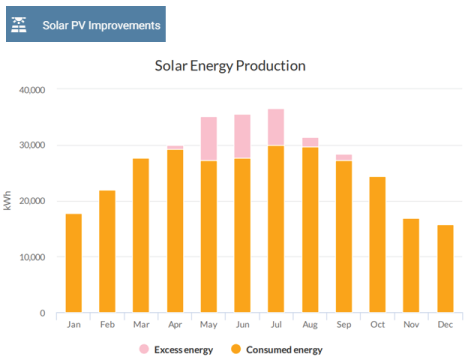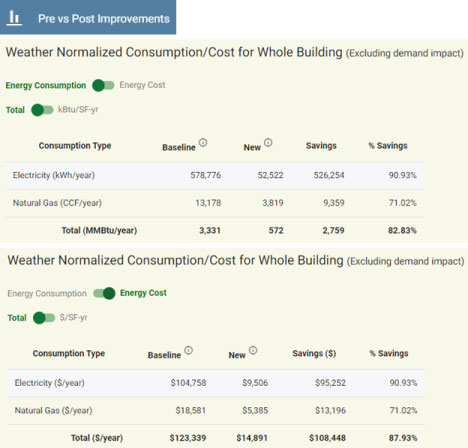
SRS Blog
Building energy efficiency insights from the innovators behind EPICBackground
As a pioneer in cloud-based building energy performance assessment technology, SRS has earned a reputation for developing cutting edge software, data, and predictive analytics solutions. Our latest innovation is the Energy Performance Improvement Calculator (EPIC™).
EPIC has been enthusiastically adopted across the ecosystem of energy efficiency project professionals for its ability to estimate a project’s energy savings, carbon emissions reduction and key financial metrics – in real time and with minimal data inputs.
Market Developments
The Inflation Reduction Act (IRA) of 2022 extended the Investment Tax Credit (ITC) through 2032 and increased its value from 26% to 30%. As a result, building owners can now receive a 30% credit of the cost of a solar PV system on their federal income taxes.
This ITC increase, in conjunction with enhanced utility incentives for energy efficiency (EE) improvements, e.g., electrification of space heating systems, and increasing commitments by building owners to achieve net-zero GHG emissions, has spurred growing focus on the financial and environmental benefits of EE and solar PV investments.
In response, EE project developers, HVAC and solar PV contractors need to be prepared to answer the following key building owner questions:
- What is the upfront investment and operating cost impact to electrify my building?
- What is the optimized combination of EE and solar PV improvements for my building?
- What is the investment required to achieve net-zero GHG emissions for my building?
Answering these questions requires a technically sound methodology that adheres to industry best practice: “energy efficiency first” and then “right-sizing” a solar PV system to the building’s post-EE improvements’ baseline electricity consumption.
Such EE optimization analysis has typically required a time and cost-intensive building energy simulation modeling effort that most building owners are unwilling or unable to pay for – particularly in the feasibility assessment stage. Furthermore, such integrated EE + solar PV project analysis requires the collaboration of multiple contractors, e.g., HVAC, lighting, and solar PV, to collect their proposed equipment specifications and account for the interactive effects.
Unfortunately, the industry has historically lacked the tools to enable such time and cost-efficient collaboration to prepare an integrated EE + solar PV analysis. As a result, project developers and contractors have typically been unable to provide building owners with a consolidated business case to confidently invest in EE + solar PV projects that will achieve their energy efficiency, electrification, and net-zero GHG emissions goals.
New Feature
To solve this long-standing industry challenge and meet the growing demand for integrated EE + solar PV project cost-benefit analysis, we are pleased to announce the launch of the EPIC Energy Efficiency + Solar PV feature.
This new functionality empowers EPIC users to develop EE + solar PV projects, including best practice methodology: “energy efficiency first” and then “right-sizing” a solar PV system to optimize financial and GHG emissions reduction impacts.
How it Works
EPIC’s Building Information section: Enter the subject building’s existing heating and cooling source and select your project’s energy improvements, i.e., like-for-like equipment replacement, electrification via heat pumps/variable refrigerant flow technology, LED lighting, solar PV system, etc.


EPIC’s Key Assumptions section: Enter the subject building’s annual utility consumption and unit cost data. Alternatively, if the utility consumption and cost data is unavailable, EPIC will provide default values to enable preliminary estimates. These pre-populated default values are based on:
- Annual energy consumption: Median energy use intensity of peer buildings located in the same geographic area as the subject building. Source: U.S. Energy Information Administration’s Commercial Building Energy Consumption Survey.
- Annual energy cost: Average unit costs for electricity and natural gas for buildings in the same state as the subject building. Source: U.S. Energy Information Administration’s Monthly Power Report.

EPIC’s Energy Improvements section: Based on the subject building’s characteristics, baseline energy consumption and costs data, and selected energy improvements, EPIC will estimate the net installed cost, utility consumption and cost savings, and key financial metrics, e.g., savings to investment ratio for each improvement and at the project level.

By clicking on the “plug” enable icon to the left of the Solar PV improvement line item in the Energy Improvements table, EPIC users can access the solar PV system specifications default values.

Using NREL’s PVWatts® for the subject building’s location, EPIC estimates the default value for the solar PV system size (kW DC) needed to satisfy approximately 90% of the building’s electricity consumption after accounting for the estimated energy savings impact of any energy efficiency improvements, e.g., HVAC, LED lighting, etc.

Furthermore, by clicking on the arrow to the left of Energy Production by Month, EPIC users have the option to enter their own Energy Production by Month values based on estimates from their preferred solar PV energy production software tools, e.g., PVWatts®, HelioScope, etc.
In such scenarios, these user-provided monthly production values, which include assumptions for panel tilt and azimuth angles, system losses and performance degradation, etc., will be used by EPIC to calculate the solar PV system’s annual energy production (kWh) consistent with third-party solar PV software tools.

Upon EPIC user’s review, edits (where applicable), and submission of key specifications, i.e., solar PV system size, cost, Renewable Energy Credit program data, utility net-metering program billing interval and electricity buyback rate data, EPIC will estimate integrated financial metrics for both the EE and solar PV improvements.
EPIC’s Solar PV Improvements section: EPIC estimates the solar PV system’s monthly energy production and the estimated solar energy consumed by the subject building. In months where the solar energy production exceeds the subject building’s estimated electricity consumption, EPIC estimates the “excess energy” exported to the utility grid or onsite energy storage facility.
EPIC’s methodology includes:
- Estimation of the subject building’s monthly electricity consumption based on weather normalized (average seasonal weather conditions) end-uses, e.g., space cooling and heating (when the subject building uses electricity for space heating)

- Comparison of the solar PV system’s estimated monthly energy production (kWh) to the subject building’s electricity consumption
- Calculation of excess monthly solar PV energy production, i.e., energy exported to the grid or onsite energy storage facility.
Furthermore, the EPIC methodology considers the net-metering analysis interval, i.e., monthly, quarterly, annually, (where net-metering is applicable) in the calculation of the solar PV system’s annual energy produced, consumed, and exported. These data are displayed on the Solar Energy Production chart to illustrate that portion of monthly solar PV-produced electricity consumed by the subject building and the excess portion that is exported to the utility grid or onsite storage facility.


EPIC’s Pre vs Post Improvements section: Upon the EPIC user’s submission of final EE and solar PV improvement specifications, EPIC calculates pre vs post improvements’ consumption and cost savings metrics.

Furthermore, EPIC calculates the subject building’s pre vs post improvements’ energy use intensity (EUI) and compares its EUI performance to its peer group’s median EUI.

EPIC’s Project Summary section: Upon the EPIC user’s submission of EE and solar PV improvement specifications, EPIC calculates post-improvements GHG emissions reduction (CO2e/yr./MT). These estimates provide building owners with visibility to potential achievement of net-zero GHG emissions goals.

EPIC-generated PDF reports now support the creation of an EE + solar PV project consolidated business case. These analytics will ensure building owners have the information they need to confidently invest in energy improvements designed to achieve their energy efficiency, electrification, and net-zero GHG emissions goals.
Conclusion: Cities and states increasing adoption of building energy performance and GHG emissions legislation coupled with building owners’ increasing commitment to net-zero GHG emissions goals has driven building energy efficiency, electrification and decarbonization to the forefront in the commercial buildings’ sector.
Building owners considering energy improvements for their properties will be well served to carefully evaluate the financial and environmental impacts of EE + solar PV equipment options to answer their key investment due diligence questions.
What’s needed to meet this critical market need are the tools and technical assistance services to create a clear, coherent, consolidated business case that integrates and compares the financial and environmental benefits for multiple scenarios:
- Like-for-Like: upgrade to high efficiency HVAC equipment
- Electrification: convert to electric space heating with heat pumps/VRF technologies
- Comprehensive Projects: consider other potential energy saving improvements like LED lighting retrofits and envelope upgrades
- Net-Zero: right-size solar PV to post-EE improvement’s new baseline
- Financing: evaluate financing options and their projected cash flow impact to operating income.
Enabled by EPIC’s new EE + solar PV features, EE project developers, HVAC and solar PV contractors now have a time and cost-effective collaboration tool to prepare the consolidated business case that building owners need to confidently invest in EE + solar PV improvements toward achieving their energy efficiency, electrification, and net-zero GHG emissions goals.
To discuss how this new EPIC Energy Efficiency + Solar PV feature can support your project’s cost-benefit analysis, Contact Us to schedule a demonstration.

About the Author
Brian J. McCarter is Chief Executive Officer at Sustainable Real Estate Solutions. Mr. McCarter has been a leader in the commercial real estate software and due diligence information services market for over 25 years. He may be contacted through our Contact page.

